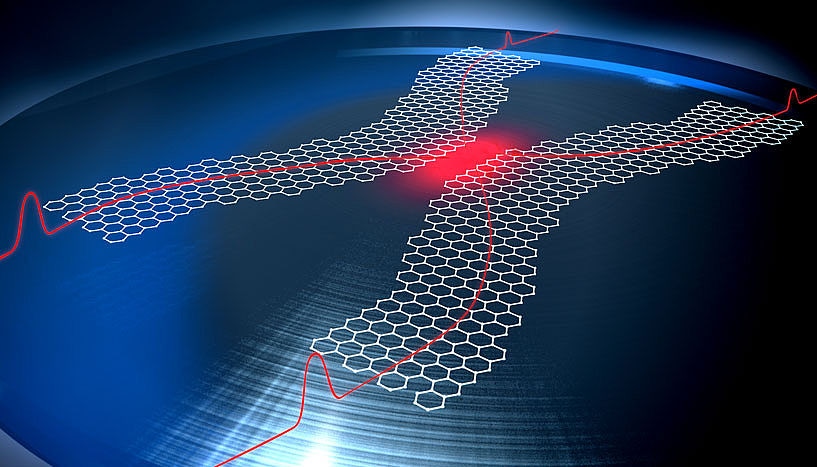May 7 2019
A new material made up of a single sheet of carbon atoms could pave the way for innovative designs for optical quantum computers.
 Schematic of a graphene-based two-photon gate. (Image credit: University of Vienna, created by Thomas Rögelsperger).
Schematic of a graphene-based two-photon gate. (Image credit: University of Vienna, created by Thomas Rögelsperger).
Physicists at the University of Vienna and the Institute of Photonic Sciences in Barcelona have demonstrated that customized graphene structures allow single photons to interact with one another. The new architecture put forward for quantum computer has been reported in the latest issue of npj Quantum Information.
Photons hardly ever interact with their surroundings, rendering them a preferred candidate for the storage and transmission of quantum information. This same property makes it specifically hard to manipulate information encoded in photons. To develop a photonic quantum computer, it is necessary for one photon to change the state of another. Such a device is known as a quantum logic gate.
Millions of logic gates will be required to create a quantum computer. One method to realize this is to employ what is called a “nonlinear material” in which two photons interact within the material. Sadly, standard nonlinear materials are highly inefficient to be used to develop a quantum logic gate.
Recently, it was observed that it is feasible to considerably improve the nonlinear interactions by using plasmons. In a plasmon, light is tethered to electrons on the material’s surface. The electrons can then assist the photons in interacting in a much more strong manner. But plasmons that exist in standard materials decay even before the required quantum effects can occur.
As part of the new study, the group of researchers headed by Prof. Philip Walther from the University of Vienna intend to produce plasmons in graphene. Graphene, a 2D material discovered only 10 years ago, is made up of a single layer of carbon atoms in a honeycomb arrangement. From the time it was discovered, it has never ceased to surprise the humankind. For this specific purpose, the unique configuration of electrons in graphene not just results in an extremely strong nonlinear interaction but also leads to plasmons that have a remarkably longer lifetime.
In the graphene quantum logic gate proposed by the scientists, they demonstrate that by creating single plasmons in nanoribbons made of graphene, two plasmons in different nanoribbons can be made to interact through their electric fields. Given that each plasmon remains in its ribbon, it is possible to apply multiple gates to the plasmons, which is essential for quantum computation.
We have shown that the strong nonlinear interaction in graphene makes it impossible for two plasmons to hop into the same ribbon.
Irati Alonso Calafell, Study First Author, University of Vienna
The scheme proposed by the researchers uses various peculiar properties of graphene, each of which has been noted individually. At present, the group from Vienna is conducting experimental measurements on an analogous graphene-based system to verify the feasibility of their gate with existing technology. As the gate is obviously small and functions at room temperature, it should readily lend itself to being scaled up, as is the demand for various quantum technologies.